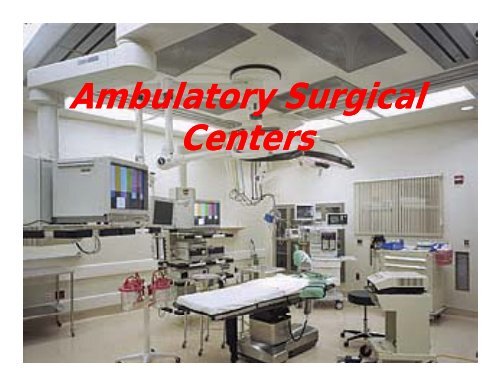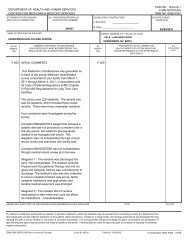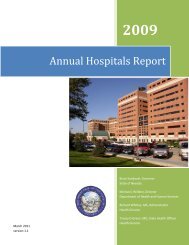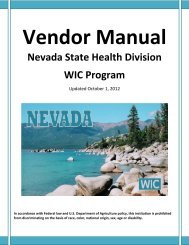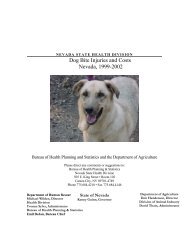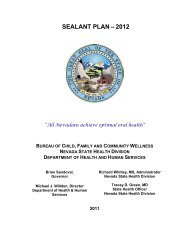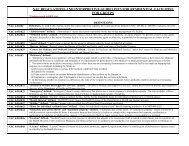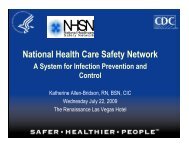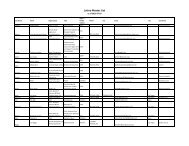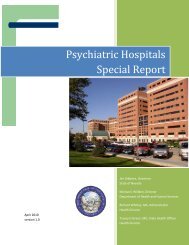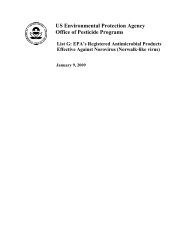Ambulatory Surgical Centers - Nevada State Health Division
Ambulatory Surgical Centers - Nevada State Health Division
Ambulatory Surgical Centers - Nevada State Health Division
You also want an ePaper? Increase the reach of your titles
YUMPU automatically turns print PDFs into web optimized ePapers that Google loves.
<strong>Ambulatory</strong> <strong>Ambulatory</strong> <strong>Surgical</strong> <strong>Surgical</strong><br />
<strong>Centers</strong> <strong>Centers</strong>
<strong>Ambulatory</strong> <strong>Surgical</strong> <strong>Centers</strong><br />
•Overview<br />
Outline Outline<br />
• IInfection f ti CControl t l RRules l and d<br />
Regulations<br />
• Hepatitis C Outbreak in <strong>Nevada</strong><br />
• Recovery y<br />
Act
Overview<br />
• 59.47% increase in ASCs since 2002<br />
• 43% of same- day surgery<br />
• 15% of all ASCs with Condition Level<br />
Noncompliance p during g<br />
FY 2008
Updated Regulations<br />
• New SOM in effect May y 18, , 2009<br />
• Aspen tags and regulatory text revised and<br />
renumbered<br />
• Addition of CoP for Infection Control<br />
• Infection Control Tool
ASC Guidelines for Infection Control<br />
CFR 416.51 Condition of Participation: Infection Control<br />
• “Th “The ASC must t maintain i t i an infection i f ti control t l program<br />
that seeks to minimize infections and communicable<br />
diseases.”<br />
Standards (Q241-Q245)<br />
• Sanitary Environment<br />
• Ongoing IC program following IC guidelines<br />
• Qualified professional directs IC program<br />
• IC program an integral i t l part t of f QAPI<br />
• IC program has a plan of action for combating infections<br />
and communicable diseases
Survey Process<br />
• Off-Site Survey Preparation<br />
• Entrance Activities<br />
• Information Gathering/ g Investigation g<br />
• Preliminary Decision-Making and Analysis<br />
of Findings<br />
• Exit Conference<br />
• Post- Survey y<br />
Activities
Survey Procedures for Infection Control<br />
CFR 461.51 Conditions for Coverage<br />
IC Survey Procedures:<br />
Infection Control Tool<br />
• Developed by CDC, comprehensive tool to assist<br />
surveyors in evaluating the IC practices of an ASC<br />
(SOM Exhibit 351)<br />
• One surveyor assigned to complete this tool during<br />
survey, but all surveyors on the look out for<br />
possible IC breaches<br />
• Tool utilizes combination of direct observations<br />
and interviews
Infection Control Tool
Interpretive Guidelines:<br />
Infection Infection Control Program<br />
Program<br />
SOM Appendix pp L Tag g Q240 Q<br />
• Maintenance of an Infection Control Program<br />
– Functional and sanitary y environment<br />
– Based on nationally recognized guidelines<br />
– Directed by designated I.C. professional<br />
– Integrated into QAPI program and ongoing<br />
– Actions to prevent, identify and manage infections<br />
– MMechanism h i for f immediate i di t implementation<br />
i l t ti
Standard 416.51(a) (Q241): Sanitary Environment<br />
Survey Su ey Procedures ocedu es<br />
• Observe throughout the ASC the cleanliness of the<br />
waiting areas, areas the recovery rooms rooms, the OR/procedure<br />
rooms, floors, horizontal surfaces, patient equipment,<br />
air inlets, mechanical rooms, supply, storage areas<br />
• Interview staff to determine whether cleaning/<br />
disinfection takes place appropriately. Ask for<br />
supporting documents to confirm interviews<br />
• Determine whether ASC has procedure for<br />
decontamination after spills of blood or other bodily<br />
fluid, whether used sharps are properly disposed, and<br />
whether ASC re-uses single use devices. If so, are they<br />
sent to an FDA-approved FDA approved vendor for reprocessing?
Standard 416.51(b) (Q242): Maintaining<br />
ongoing ongoing IC IC program program Survey Survey Procedures<br />
Procedures<br />
• Determine whether ongoing program for<br />
prevention, control and investigation of<br />
infections and communicable disease among<br />
patients and ASC personnel exists<br />
• Determine whether policies and procedures of<br />
IC program are implemented correctly<br />
• Review parameters of the program to<br />
determine whether it is consistent with<br />
nationally recognized IC guidelines. Is there<br />
documentation that the ASC has developed p<br />
procedures and policies based on these<br />
guidelines?
Standard 416.51(b)(1) (Q243): IC Program under<br />
Qualified Qualified Professional<br />
Professional<br />
Survey Procedures<br />
• Determine whether a qualified individual has<br />
been designated with the responsibility of<br />
leading the IC program<br />
• Review personnel p file of the IC individual to<br />
determine whether he/she is qualified through<br />
ongoing education, training, or certification to<br />
oversee the h IC C program
Standard 416.51(b)(2) (Q244): IC<br />
Program Program integral part of QAPI Program<br />
Survey y Procedures<br />
• Determine whether ASC’s QAPI program<br />
includes measures/indicators and activities<br />
related to IC on an ongoing basis<br />
• Determine whether there is evidence that QAPI<br />
IC activities result in specific actions designed<br />
to improve IC within the ASC
Standard 416.51(b)(3) (Q245): IC Program<br />
responsible for providing providing a plan of action<br />
Survey Procedures<br />
• Ask IC professional to describe an actual<br />
example of how, as a result of the action<br />
plan, IC issues were identified and<br />
corrected. Ask for documentation to<br />
support.<br />
• Ask IC professional to review IC plan of<br />
action with h you and d explain l how h it<br />
addresses basic elements of an IC<br />
program program.
What Surveyors are looking for:<br />
SOM Appendix pp L (Q241-Q245)<br />
(Q Q )<br />
• Sanitary Environment<br />
• Ongoing IC program<br />
• IC Program following recognized IC guidelines<br />
• Qualified IC trained professional as director<br />
• Identification and reporting system to track<br />
infections<br />
• Staff receive IC training<br />
• Correct IC practices
Preventing Preventing the the Spread Spread of of Infection Infection<br />
in in in in ASCs ASCs ASCs ASCs<br />
• Maintenance of Sanitary Environment<br />
• Implementation of appropriate prophylaxis<br />
• AAseptic ti techniques t h i<br />
• Hand washing<br />
• Safe injection practices<br />
• Appropriate use of equipment<br />
• Disinfectants, antiseptics, and germicides<br />
• Education
Reuse Reuse Results Results in in<br />
Condition Condition Condition Condition Level Level Level Level Noncompliance<br />
Noncompliance<br />
Noncompliance<br />
Noncompliance<br />
• Needles<br />
• Syringes<br />
• Medication vials (single ( g dose) )<br />
• IV solution bags<br />
• Medication administration tubing g and<br />
connectors<br />
• Reprocessed p single-use g devices without<br />
approval by FDA or FDA- approved<br />
reprocessor for reprocessing
ASC ASC Hepatitis Hepatitis C C Outbreak Outbreak<br />
<strong>Nevada</strong> <strong>Nevada</strong> <strong>Nevada</strong> <strong>Nevada</strong> 2008 2008<br />
2008 2008
When infection isn’t prevented…<br />
Hepatitis epattsCOutb C Outbreak ea 2008 008<br />
• January 2, 2008- 2 cases of Hepatitis C<br />
discovered at 1 facility y during g complaint p<br />
investigation by state surveyors<br />
• CDC identified 4 additional cases<br />
• January 17,2008- 17,2008 Facility corrected unsafe<br />
injection practices but still noncompliant with<br />
2 CoPs during Federal Survey by state<br />
surveyors<br />
• January 30, 2008- Sister facility received<br />
<strong>State</strong> Licensure and Federal Survey by state<br />
surveyors and found to be noncompliant with<br />
3C 3 CoPs, P including i l di reuse issues i<br />
• Source- Reuse of syringes and multi-use of<br />
single-dose medication vials<br />
• Both facilities closed due to termination of<br />
business license
When infection isn’t prevented…<br />
Hepatitis C Outbreak 2008<br />
2008<br />
• February y 15, , 2008- Third facility y received <strong>State</strong><br />
Licensure Survey and Federal Survey by <strong>State</strong><br />
Surveys and many IC problems identified<br />
• Late February- CMS notified by <strong>Nevada</strong> Bureau<br />
of Licensure and Certification of potential<br />
outbreak tb k<br />
• February 27, 2008- Southern <strong>Nevada</strong> <strong>Health</strong><br />
District and NBLC held joint press conference
When infection isn’t prevented…<br />
Hepatitis C Outbreak 2008<br />
2008<br />
• March 5- April p 4, , 2008- All ASCs received<br />
<strong>State</strong> Licensure Surveys<br />
• March 6- May 12, 2008- 25 Federal Surveys<br />
Conducted (In addition to 3 conducted<br />
earlier by <strong>State</strong>)<br />
• June 5, 2008- 77 additional cases of<br />
Hepatitis C linked to first facility<br />
• June 2008- Hepatitis C Registry created<br />
• 53,000 patients possibly infected with<br />
HHepatitis titi BB, CC, and d HIV
Response p by y <strong>State</strong><br />
All 51 of <strong>Nevada</strong> ASCs received<br />
<strong>State</strong> <strong>State</strong> Licensure Licensure Surveys Surveys<br />
• 28 of 51 surveyed by the state had deficiencies<br />
100%<br />
80%<br />
60%<br />
40%<br />
20%<br />
0%<br />
1 2 3 4 5 6<br />
X Axis Details<br />
1. Steralization/ Disinfection Issues<br />
2. Reusing Single Dose Vials For Multiple Patients<br />
3. Biological Testing Issues<br />
4. Noncompliance with Manufacturer's Recommendations<br />
5. IC Deficiencies<br />
6. No Deficiencies<br />
Total # ASCs<br />
Surveyed<br />
ASCs with<br />
Problems
Response p by y CMS<br />
28 ASCs received federal surveys<br />
• 64% Condition Level Noncompliance<br />
• 93% Federal F d l citations it ti<br />
• 60% Infection Control issues<br />
• 14% Syringe and single dose vial reuse<br />
• 18% Involuntary terminated
% of ASCs with Infection Control Issues<br />
during Federal Federal Survey<br />
% of o ASCs with w Infectioon<br />
Control/<br />
Reusee<br />
Deficienccies<br />
70<br />
60<br />
50<br />
40<br />
30<br />
20<br />
10<br />
0<br />
Single dose Vial and<br />
Syringe Reuse<br />
IC Deficiencies<br />
# of ASCs % of ASCs<br />
Single dose vial and Syringe Reuse 4 14<br />
Some level of Infection Control Deficiencies 17 60
2008 Pilot Program g<br />
• Maryland, Oklahoma, North Carolina<br />
• Test of a new II.C. C survey instrument<br />
and use of tracer methodology<br />
• Findings
American Recovery and Reinvestment<br />
Act Initiative<br />
Initiative<br />
“To To carry carry out out activities activities to to implement implement<br />
healthcare-associated infections<br />
reduction strategies”<br />
• 10 million to expanding ASC oversight<br />
• Implement new survey process<br />
• Increase frequency of inspections
Recovery Act impact on survey<br />
procedure procedure…<br />
Additional Features:<br />
• Infection Control Instrument<br />
• Tracer Methodology gy<br />
• Additional Surveyor<br />
• Frequency q y of surveys y increase to 33% of<br />
ASCs per year
Recovery Act Implementation<br />
• 10 million dollars for <strong>State</strong> Agencies<br />
• Full implementation of new survey process<br />
by FY 2010
July y 2009<br />
Recovery Act Schedule<br />
• Selection of states for 2009 implementation<br />
• Start implementation in 2009 volunteer states<br />
August 30, 2009<br />
• Submission of plan for FY 2010 funding<br />
September 2009<br />
• Notice to states of FY 2010 approval and<br />
funding levels<br />
October 2009<br />
• In-person training- All states
Recovery Act<br />
GOALS<br />
• Expand <strong>State</strong> Survey Agency’s capability<br />
for conducting ASC surveys<br />
• Ensure ASCs follow appropriate IC<br />
standards and practices<br />
• Improve IC deficiencies
Implications of Recovery Act<br />
GOALS<br />
• Double # of ASCs surveyed y<br />
• 1/3 of all non-accredited ASCs surveyed<br />
• 50% increase in IC deficiencies identified<br />
• 95% of identified Condition-level deficiencies<br />
remedied within 14-180 days y of the Plan of<br />
Correction
Thank you! y<br />
Questions?<br />
steven.chickering@cms.hhs.gov<br />
415-744-3679<br />
Website<br />
http://www http://www.cms.hhs.gov/Survey<br />
cms hhs gov/Survey<br />
CertificationGenInfo/01_Overvi<br />
ew.asp#TopOfPage


